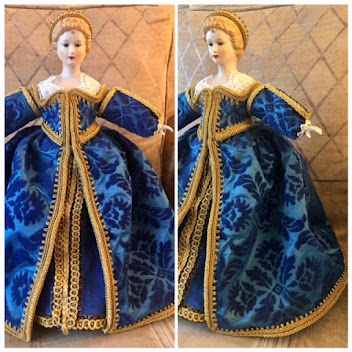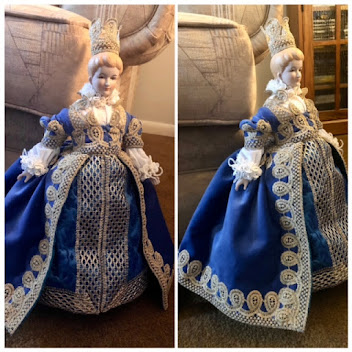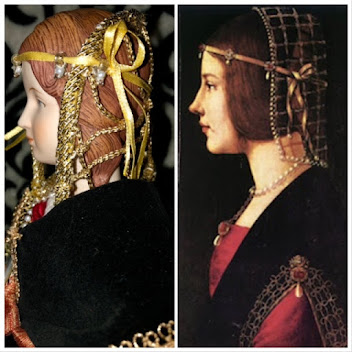With the My local SCA kingdom opening up around June 01, 2021. I am apprehensive at best at returning to normal. After spending a year avoiding people, even family, for fear of catching Covid-19. I think its still too soon to be attempting events even with no food, masks, social distancing in place. Not enough people have been vaccinated and my state is allowing it this week for the general public. It will be sometime to develop immunity and boosters are more likely the way to deal with variants as they arise. So no events for more than likely the rest of 2021 to be safe, the case number will dictate after vaccination.
 |
| Woodcut of Turner Making Dolls |
So with that in mind, going to dive into a research hole as it kept me sane this long while. I have been considering all the woodworking techniques that are used in medieval times to make art; specifically dolls/statues. As I have been able to learn woodcarving by hand during the pandemic. Lathe work is something that intrigued me since there were notable furniture that was heavily carved in Tudor times. There had to be a way that objects could be mass produced in a quick manner using tools, jigs and other such methods as compared to all hand work. Well why not apply this to doll making too, as it was a known industry during this time in history?
The Lathe is an ancient tool, it was first painted and documented by a wall painting by Ancient Egyptians 3rd century BC. There is also tenuous evidence for its existence at a Mycenaean Greek site, dating back as far as the 13th or 14th century BC. There are evidence from 6th century turned items found in Etruscan tombs.(wikipedia) So this technology was used in the ancient world, in several geographical locations. Makes sense technology spread to new areas over time. Early evidence of wood turning in England dates from the 4th to the 7th century(3), and by 1180 there appears to have been a turner's guild established in Cologne, Germany(4) (bloodandsawdust.com). The Dochenmacher guild, or Doll Makers guild was slower to develop than the turning trade, they were noted in Nuremberg, Germany as a guild in 1418. Although the market was well established enough for guild status and the reputation of quality wooden products from the continent would be largely unchallenged for centuries. Moving forward to Tudor times, turned objects could be sold at local marketplaces or even shipped abroad on the European continent. Trade of good was always important, whether local, regional or international. I did find some sources that list dolls as an export and import to England during this time. Small relatively light weight even in bulk, dolls and toys would be easy cargo for transport.

Medieval European turners favored a design called a "spring pole" lathe.
In this form, a frame, usually of sufficient height for the turner to stand,
holds the piece being turned between two upright posts (called poppets or puppets) on sharp
metal points (called centers). One end of a cord is attached overhead to a pole or similar "springy"
mechanism to provide recoil. The cord is then wrapped around the piece to be turned and attached to a
foot treadle. The turner cuts on the down stroke, and then lets the spring pole power the return motion.
Later variations of the design incorporated a lever arm so the spring pole could be mounted to the base
of the frame instead of overhead, or replaced the pole entirely with a bow mounted on upright posts.
(bloodandsawdust.com)
The spring pole design proved versatile. It could be made light and portable, important to craftsmen who might travel to where raw materials were plentiful. It was relatively easy to build and required few parts that the turner could not himself make. There are drawbacks to this elegant design however, such as relatively slow turning speeds and limitations on the size and weight of the object that could be turned. Yet despite these limitations, the spring pole lathe would remain popular well into the 19th century among chair makers and other traditional crafts. (bloodandsawdust.com)
 |
| Bartholomew Baby |
One of the challenges with using this machine to make dolls, is "in the round" concept. People are symmetrical for the most part but our curves are not the same front to back, how could this be represented in a turned doll?
The answer is by finishing techniques. A Turner would come up with a general shape to turn the wood or other chosen material. Then the more human like features can be carved into the doll like smoothing the back, separating arms, and legs, or be added all together later.
Bartholomew Baby- A wooden doll, generally without arms or joints, painted and dressed in current fashions.
There is a image of a reproduction Bartholomew baby that I found online that closely follows this concept. This image to the right shows it roughly turned and sanded. Eventually the doll could be painted, a wig/cap added, and clothing arranged around the wooden form. Arms could be made of leather or wire to be poseable and easily removable to dressing/ redressing.
So in conclusion, its known that turned wooden dolls were a commodity sold at market. Some were made of other materials as later discovered by archaeological finds in the Thames. The dolls could be sold fully dressed or undressed(naked) for clothing to be fashioned by the owner. Wooden dolls making could use not just hand tools but a mechanical lathe to create large numbers to meet and exceed market demand.
A journey begin with one step,
Marrin






No comments:
Post a Comment